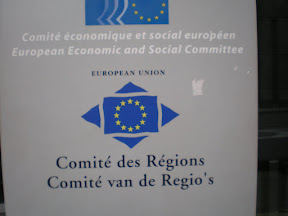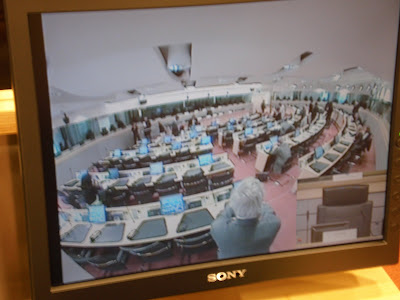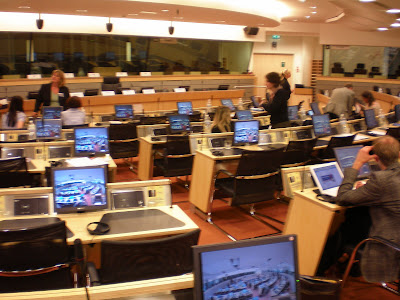An European Workshop in Brussels 22.5.07 [EN]
"Skills for sustainable and competitive Communities": The title of an European workshop I attended today in the Brussels Belliardstreet. It was organised by the Quartiers-en-Crise/European Regeneration Areas Network (QeC-ERAN), a NGO of urban governments, officials and practicians. I told about it yesterday in the E-Urban Journal.
It was a very good and efficient conference, well designed to promote a new objective of QeC with other networks and (European) institutions. This objective is: More and better organised training on an European level for those urban practicians, who are engaged in "integrated approaches" (area-based projects) to urban zones that need to be regenerated.
I will report about it seriously in the E-Urban journal one of these days.
But those who are acquainted with the former "Huibs' URBLOG", know, that I am always inspired by this kind of occasions to some irrespectful (or is it irreverent?) observations. Which may, I am convinced of it, often be more to the (power-)point than the respectful ones...
The venue of the conference was the building that also houses the European Committee of the Regions.
It is located in the Brussels Belliardstreet, a seven-lane one-way avenue that leaves only a few space for pedestrians, who move between the European Parliament, the European Council and a series of Europe-linked offices. I know, for I arrived by public transport.
European conference rituals
After a thorough search by security personnel, and arriving in the conference room, I immediately felt at home. Somehow, somewhen, I started to LIKE these conferences. You get a bag with a logo, a sticker with your name on it, and, often, a pen and writing paper. Sometimes, even a USB-plug is offered. Here, however, only a ballpoint pen accompanied a miserable plastic folder with the conference agenda. After all, QeC-ERAN is about poor urban neighbourhoods. So that was no reason for complaint.
The more so, as the conference room showed a progress in electronic equipment that was totally new to me.
Every seat had its own (Sony) flatscreen in front of its occupant. The inevitable powerpoint-slides of the speakers were no more projected on a big screen over the podium, as became usual during the last five or ten years. They appeared on your personal screen. And, more stunning still, an invisible hand focussed invisible webcams on speakers and people who intervened with questions or remarks from their seat in the room. Above, you can see an image, I took from my personal screen, showing an overview of the meeting room. I happened to be just in front of that camera, so you can see my back as I took the picture from my screen.
The last progress in electronic conferencing, before we all go on the Net...
I do not know, if this Big-Brother-like system has been intentionally designed for it, but I immediately realised, that I urgently need a haircut. Later on, during the meeting, I discovered, that there was no invisible hand that steered the cameras, no: the whole system is automatic and interactive! I pushed a button on my personal microphone in order to say something in the discussion, and, to my horror, on my screen (and on every one of the other hundred screens) appeared an enormous image of my face... I instantly forgot what I had to say, pushed several other buttons, but I remained in the focus. Until, finally, someone else pushed his or her button and started to speak.
Below is a normal image of the conference room (not taken from a screen):
And I wondered: Why did we physically meet in a classic conference room? The webcam-screen system could easily have been operated by way of the internet. The conference-modus of MSN-Messenger, of Yahoo and of Skype offer already the same possibilities as were imposed on us at the workshop. Clustered to your screen, no time to look around , to observe or to smell other humans, all occupied by interactive operation of powerpoint presentations or focussing the webcam on yourself - it can (and is being) done all the time.
The only occasion for physical nearness was the Lunch. Served by one of the many good Brussels traiteurs (cod and salmon), it had to be consumed standing in a corner of the hallway. It wasn't served on screens, but I am sure, there will be a way to do that also by the Web or by email (an e-meal?).
A distressing belly-dance
Finally, at the end of the day, a rebellious lady broke the spell of the cameras and the screens. She STOOD! She delivered her speech, inviting us to maintain old-fashioned eye-contact with her, while she stood upright behind the pulpit. A revolution! The whole sytem broke down, for the fixed webcam only captures SEATING people. So, during her talk, on all our hundred screens, we saw her belly. Nothing but her unremarkable, well-dressed middle part! Corinne Hermant-de Cattalaÿ, you stole my heart! Even if your message was as distressing as could be. Corinne had to explain how uncoordinated, un-integrated the European funding structure for cities with integrated development approaches is, during the next seven years. In spite of her play with the camera, it was no belly-dance at all, so to say.
Giving a voice to overworked, unsufficiently supported, urban practicians
But, undoubtedly, she made the best of it. The same should be said of QeC-ERAN Director Haroon Saad's presentation of the audit (evaluation) they made of an enquête (questionnaire) among urban practicians. An urgent need for more training and communication facilities on an European level, with some remarkable focal points, such as conflict resolution, was seen. And very convincing, too.
Managing conflicting institutions
- Ah, suddenly I remember, what I wanted to ask when the screen flashed my ugly face so unexpectedly. I wanted to ask, which kind of conflicts to be resolved, the respondents have in mind, thinking that it is NOT about personal or personnel conflicts, but mostly conflicts with- and between INSTITUTIONS. Institutions are a forgotten category among the elements, the local urban practitioners have to deal with. They have to be taken into account from the first design of the project on. Their behaviour has to be monitored. Benchmarks to be set and kept. Project managers and, often also their political bosses, have no grip on the institutional landscape they have to work with. The institurions used to be talked about as "partners", to be lured into "partnerships". But they have their own, particular, rationale, and much tactic manipulation, supported by extra money is always needed to keep them more or less on board. It doesn't help, I think, to call them "stakeholders", as has become the buzz-word now.They still always decide at the end of the day, which one of their stakes matters them most. Too often, that is not their stake in the local project, but something else.
I wouldn't speak of "conflict resolution" in this case, but of "conflict management". For the urban project managers are not there to resolve the problems of other social and political levels. Some progress in good governance, more coordination, less infighting among services - that could be a nice side-effect of their work. No more than that. They have to work within the structures that exist. They are not God. Perhaps sometimes Angels, at most.
Women often have many of the skills needed
And one of those angels is portrayed below (another screen-take). Ilda Curti, former project manager in an extremely complicated neighbourhood of Turin, now alderman of that city in Northern Italy. She presides QeC-ERAN and led the conference with a refreshing wit. One of the reasons, I love that world of urban regeneration so much, is the presence of so many competent women like her. The work of a local urban project manager is best done with a feminine, strong and down-to-earth touch. There are many men who master that too, but more women do.
I cannot help. This lightfeeted article grew more serious than I intended. I see, that I managed to tackle two of the main points, urban regeneration pundit Jacquier made, in February in Lyon: institutions and women.
I need that haircut, and some Freud reading.

 [EN]
[EN] [FR]
[FR] [DE]
[DE]


 Huib
Huib




Reader Comments